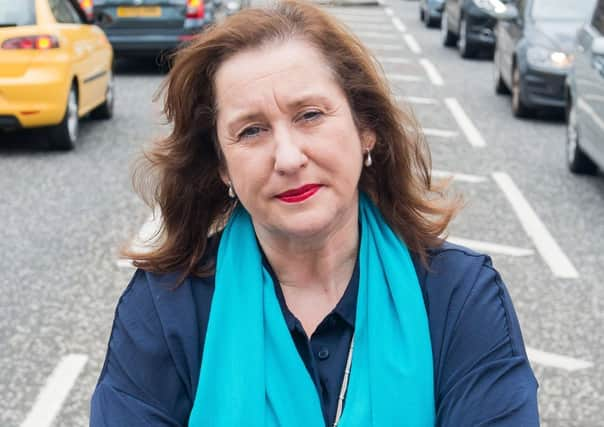Why Edinburgh drivers face ‘Attack of the Cones’


Get set for Attack of the Cones. The bridgeheads have been established and now the seemingly unstoppable march of the red and white army will soon be coming to a road near you.
There is little argument with the principle of the Spaces for People programme to cut road space and ensure pedestrians can safe-distance without walking into traffic, but there is no question that in Edinburgh at least the £5m scheme now being rolled out is a means to fund the longer-term aim of slashing car use.
Advertisement
Hide AdAdvertisement
Hide AdIt’s not a conspiracy theory, as city council transport convener Lesley Macinnes was good enough to confirm to the pro-council Edinburgh Reporter website two months ago. “It’s about the bigger picture of the resurgence of car travel,” she said. “We need to work out how to combat that right from the word go . . . active travel has to be one of those routes, and I am anxious to get as much on the ground as quickly as possible.”
The question therefore is the extent to which council minds are already made up, the impact the hastily arranged public consultations will have on its plans, and the extent to which public reaction can bring about meaningful changes to schemes which don’t work. That, of course, depends very much on how “don’t work” is defined.
With urgency limiting consultation time, such feedback as there is goes through the excitingly titled City Incident Management Team (CIMT) before implementation, in effect just senior council executives. But concerns have been quickly raised, with long tailbacks on Comiston Road prompting Daniel Johnson MSP to question the implementation despite his Labour colleagues on the city council being cheerleaders for the scheme.
If Stockbridge is anything to go by, local concerns will be politely noted and the schemes introduced anyway. Despite very detailed concerns, the response was simply that “following consideration by the CIMT, the measures have been approved for implementation.” The same standard reply has been sent in response to comments about Wester Hailes Road and Bruntsfield.
Advertisement
Hide AdAdvertisement
Hide AdOver in West Edinburgh, nearly 200 objections have been raised about new lay-outs in East Craigs and Drumbrae and all three ward councillors have condemned the lack of proper community engagement and believe the proposals will actually make matters worse for pedestrians and cyclists.
Even in these days of magic money trees, the budget for these schemes is limited and while organisations like Spokes will argue they don’t go far enough, other cyclists recognise some of the ideas are likely to cause more problems than they solve, will be of limited benefit, and the money could be better spent elsewhere.
There are plans for cycle lanes on Melville Drive, for example, even though there is already a parallel cycle path and another one on the north side of the Meadows. With nearly 100 acres of open space this is one location where social distancing isn’t a problem.
Then there are the strange anomalies. My colleague Cameron Rose, with a suspicious eye for detail you’d expect from an ex-police inspector, noticed the absence of restrictions on Liberton Road between the two schemes on Craigmillar Park and Gilmerton Road. Could this be anything to do with the £297,000 raised from drivers caught by the new bus lane cameras in just eight months, some 40 per cent of the total from all bus lane traps?
Advertisement
Hide AdAdvertisement
Hide AdBut back to Cllr Macinnes. The early roll-out was, she said, “partly about key workers and partly about exercise and free passage for other people, and also social distancing”.
That suggests social distancing was perhaps not as high in her list of priorities as might have been expected, especially as the public response demonstrated “a kind of latent desire that’s been stirred into action by the conditions” and she was trying to combine “stuff that’s coming in from the communities with what we already knew might be good possibilities”.
That was before communities knew what was happening and the complaints started to pile up, but clearly the pandemic was an opportunity for these changes, not the reason. And with no formal appeal process, no-one should be fooled into believing they are temporary.
A message from the Editor:
Thank you for reading this article on our website. While I have your attention, I also have an important request to make of you.
Advertisement
Hide AdAdvertisement
Hide AdThe dramatic events of 2020 are having a major impact on many of our advertisers - and consequently the revenue we receive. We are now more reliant than ever on you taking out a digital subscription to support our journalism.
Subscribe to the Edinburgh Evening News online and enjoy unlimited access to trusted, fact-checked news and sport from Edinburgh and the Lothians. Visit www.edinburghnews.scotsman.com/subscriptions now to sign up.
By supporting us, we are able to support you in providing trusted, fact-checked content for this website.
Joy Yates
Editorial Director
Comment Guidelines
National World encourages reader discussion on our stories. User feedback, insights and back-and-forth exchanges add a rich layer of context to reporting. Please review our Community Guidelines before commenting.